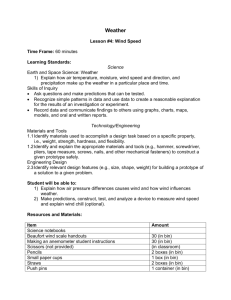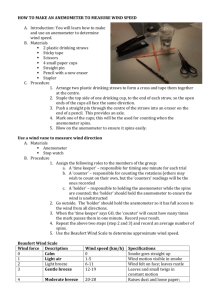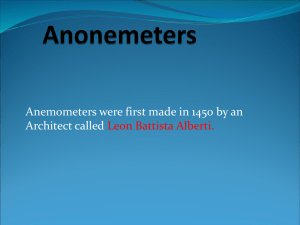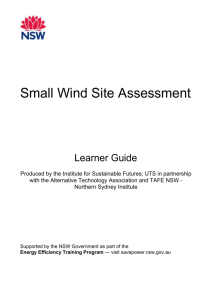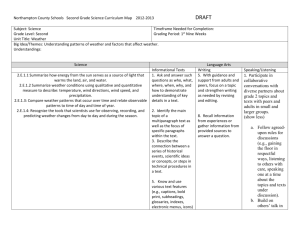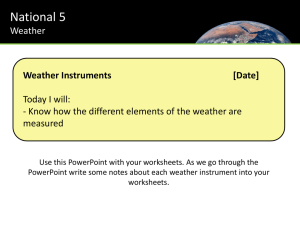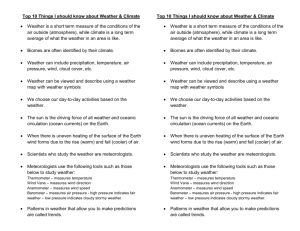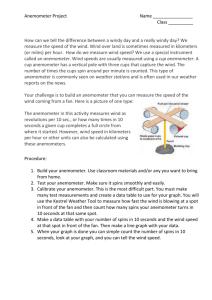Lesson 7b: Wind - Center for Learning in Action
advertisement
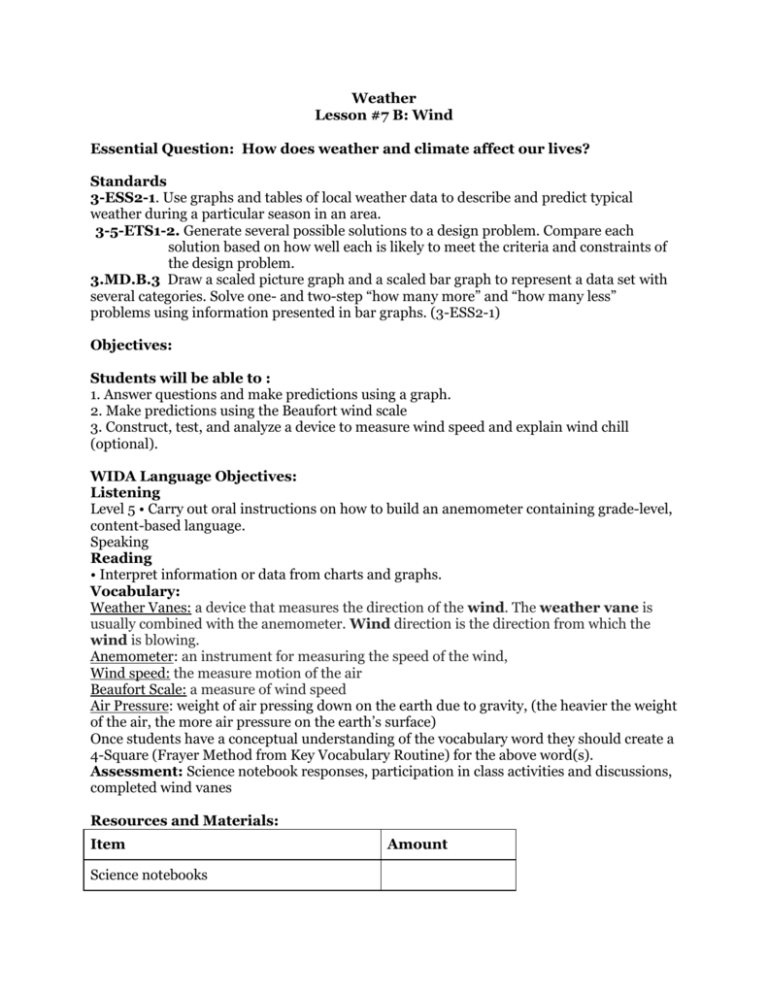
Weather Lesson #7 B: Wind Essential Question: How does weather and climate affect our lives? Standards 3-ESS2-1. Use graphs and tables of local weather data to describe and predict typical weather during a particular season in an area. 3-5-ETS1-2. Generate several possible solutions to a design problem. Compare each solution based on how well each is likely to meet the criteria and constraints of the design problem. 3.MD.B.3 Draw a scaled picture graph and a scaled bar graph to represent a data set with several categories. Solve one- and two-step “how many more” and “how many less” problems using information presented in bar graphs. (3-ESS2-1) Objectives: Students will be able to : 1. Answer questions and make predictions using a graph. 2. Make predictions using the Beaufort wind scale 3. Construct, test, and analyze a device to measure wind speed and explain wind chill (optional). WIDA Language Objectives: Listening Level 5 • Carry out oral instructions on how to build an anemometer containing grade-level, content-based language. Speaking Reading • Interpret information or data from charts and graphs. Vocabulary: Weather Vanes: a device that measures the direction of the wind. The weather vane is usually combined with the anemometer. Wind direction is the direction from which the wind is blowing. Anemometer: an instrument for measuring the speed of the wind, Wind speed: the measure motion of the air Beaufort Scale: a measure of wind speed Air Pressure: weight of air pressing down on the earth due to gravity, (the heavier the weight of the air, the more air pressure on the earth’s surface) Once students have a conceptual understanding of the vocabulary word they should create a 4-Square (Frayer Method from Key Vocabulary Routine) for the above word(s). Assessment: Science notebook responses, participation in class activities and discussions, completed wind vanes Resources and Materials: Item Science notebooks Amount Fan 1 (in bin) Beaufort wind scale handouts 30 (in bin) Making an anemometer student instructions 30 (in bin) Scissors (not provided) (in classroom) Pencils 2 boxes (in bin) Small paper Dixie cups 1 box (in bin) Straws 2 boxes (in bin) Push pins 1 container (in bin) Large plastic cups 1 bag (in bin) Packing tape 1 (in bin) Stapler (not provided) (in classroom) Cardboard square (optional) 24 (in bin) Anemometer 1 (in bin) Weather vane or picture of weather vane 1 (in bin) Wind chill chart handout 30 (in bin) Activator: Define and discuss air pressure with the class. Discuss pressure as related to the idea of weight. Ask a student volunteer to come to the front of the room and load their arm with books. Ask them how their feet feel, is there more pressure on their feet? If air weighs more, then it feels heavier. Write the definition on the board. Air pressure: weight of air pressing down on the earth due to gravity, the heavier the weight of the air, the more air pressure on the earth’s surface Introduction: Have students think back to the puppet show about wind and clouds, they did with their teacher. Remind them that wind is air moving in the atmosphere and exists because of differences in air such as temperature and pressure. As the sun warms the Earth's surface, the air in the atmosphere warms too. Some parts of the Earth receive direct rays from the sun all year and are always warm. Other places receive indirect rays, so the climate is colder. Warm air weighs less than cool air and rises. Then cool air moves in and replaces the rising warm air. This movement of air is what makes the wind blow. Today students will explore how to measure wind speed. Discuss the relationship between wind and air pressure with the class. Explain that when wind blows, air is moving away from areas of high pressure and towards areas of low pressure. Knowing the direction and speed of wind is important in making weather forecasts. Show students the sample weather vane. Explain that weather vanes are tools used to measure the direction that the wind blows. The weather vane points in the direction the wind is blowing. Introduce students to the Beaufort Wind Scale and explain that this is how winds with different speeds are described. Hand out copies of the class set of Beaufort Wind Scale student handouts. Discuss the differences between the different levels of wind. Explain that students can use these descriptions to assess the speed of the wind. This scale helps you to observe weather, but can only be used to estimate wind speeds. Tell students they will be investigating more quantitative ways to measure wind speed. Activity: 1. Ask students to brainstorm other methods to measure wind speed besides the Beaufort wind scale. Ask students to sketch their ideas or designs in their science notebooks, and an explanation of how it would help measure wind speed. 2. Explain that anemometers are tools used to measure the speed of the wind, showing students the included anemometer. Go over the procedure for making an anemometer. If the weather permits, tell students that they can test their anemometers outside when they are finished. Otherwise, use the fan provided to test the anemometers. a. Break the students up into small groups and provide them with the How To Make an Anemometer handouts and materials. Have students make predictions about how quickly the anemometer will spin in different places, or with different wind speeds. Assist student groups as necessary to construct and test the anemometer. b. When student groups are done making the anemometer go outside or use the fan to test the anemometers. Leave one or more anemometers outside and make observations over time. c. Assist the students in measuring and recording how many times their marked cup goes around in one minute. If using a fan, try to make this measurement with the fan at three different speeds. If outside on a windy day, make the measurements in 3 different locations. Use the anemometer provided to compare the results of the store-bought anemometer with the anemometers that the students made. d. Lead a class discussion of the results and ask the different students groups to share their observations and conclusions. 3. Wind Chill Extension activity (if time allows): Discuss the concept of wind chill with the class. Explain that if it is cold and windy, the wind can make the temperature on your skin feel even colder. That is why there is no recess on cold days that are very windy. Pass out the Wind Chill chart to the class and discuss how to read the chart. Why is it important to consider wind chill when making weather forecasts? 4. Have students look up http://web.williams.edu/weather/archives.ph (on iPad) Students can create different graphs of local wind data and compare them with a partner. Closure: Discuss the following questions as a class. What is wind? Where does wind come from? How is temperature related to air pressure? How can we measure wind direction? Why is it important for weather forecasters to know about wind direction? How can we measure wind speed? Why is it important to know about wind speed? How do strong winds affect humans? What makes wind strong. Exit Ticket: Using the website, have students look up the wind data for the current day and current year, and the same date in a different year. Have the students write a short paragraph comparing the two. For the two dates, have students describe the wind corresponding to the Beaufort Wind Scale. Class Handout: Beaufort Wind Scale. Use the Beaufort scale in Hands on Nature pp. 292 The following scale is for teacher information, use the scale in the book for the class. Observation Name of Wind Miles per Hour Smoke goes straight up Calm Less than 1 Smoke moves but wind vane does not Light air 1-3 Wind felt on face, leaves rustle, vanes begin to move Light breeze 4-7 Leaves and small twigs constantly moving, light flags extended Gentle breeze 8-12 Dust, leaves, and loose paper lifted, small tree branches move Moderate breeze 13-18 Small trees sway, small waves form on lakes Fresh breeze 19-24 Large tree branches move, wind howls around eaves Strong breeze 25-31 Large trees sway, not easy to walk against the wind Moderate or near gale 32-38 Twigs break off trees, hard to walk against the wind Gale or fresh gale 39-46 Branches break off trees, shingles are blown off Strong gale 47-54 Trees snap or uproot, building damage is possible Whole gale or storm 55-63 Widespread damage to buildings Violent storm 64-72 General destruction Hurricane 73 and over Student Directions: Making an Anemometer Have you ever wanted to know how fast the wind was blowing? An anemometer can help you! An anemometer is a simple tool that helps us measure wind speed. Let’s make one. Materials: Scissors Large plastic cup Pencil 4 small paper cups Packing tape Stapler 2 straws Push pin Cardboard square Directions: 1. Using a pair of scissors, carefully poke a hole through the bottom of the large cup so that the pencil can slide through. Make sure the hole is in the center to allow your anemometer to balance properly. 2. Tape the cup to the cardboard and put the pencil through the hole, eraser side up. 3. Cut off the tops of the small paper cups so they are around 1 inch tall. Using your pencil or a marker, make a large mark on one of the cups. The mark will need to be dark enough so that you can see it as it spins around in the wind. 4. Tape or staple one small paper cup onto each end of the two straws. Tape the cups so that they are facing opposite directions. 5. Place the two straws so that they make an “X” shape. Check with your teacher to make sure the cups all point clockwise around the center of the X, and then staple the two straws together and attach them to the pencil eraser with the push pin. 6. Test your anemometer! Observe your anemometer in several situations, such as a fan with multiple speeds, one student blowing “wind” while another student times them, or multiple students blowing on the anemometer. Each time, record the number of times that the marked cup goes around in one minute in the table below. Wind Source Rotations Per Minute Which wind source had the strongest effect? Why do you think this wind was stronger?
